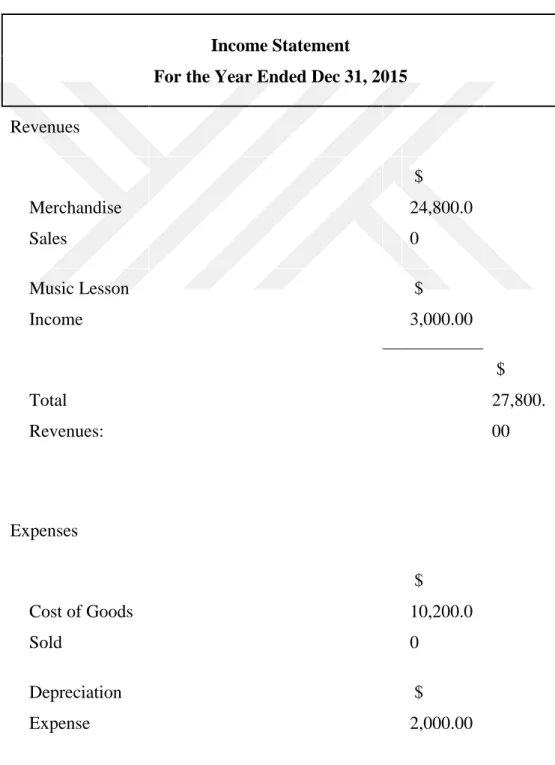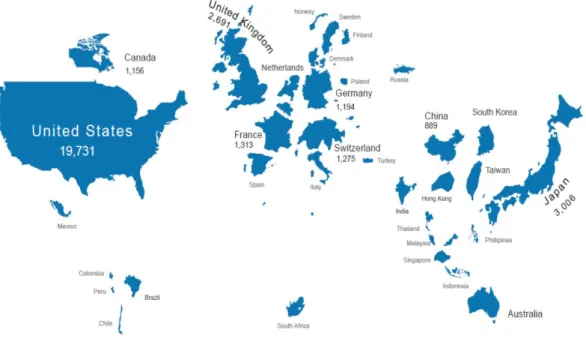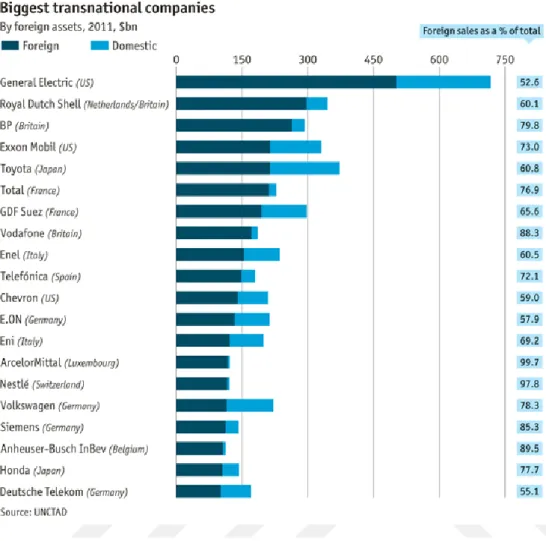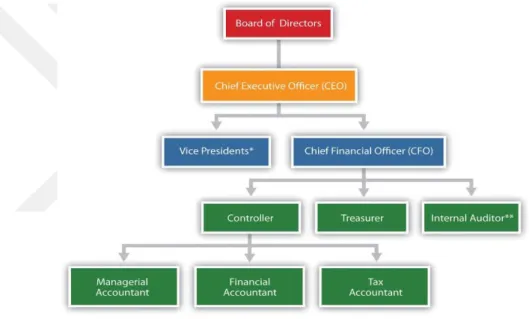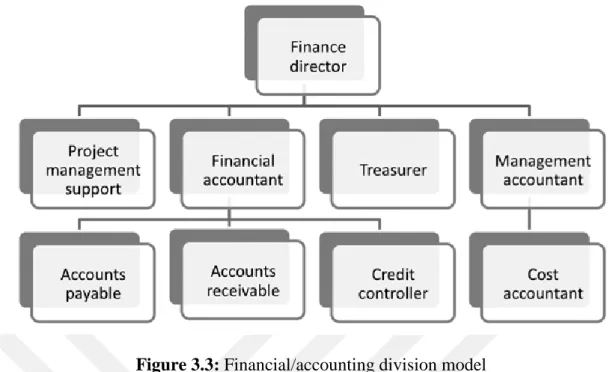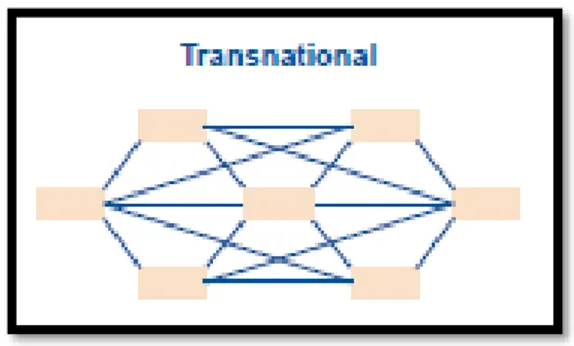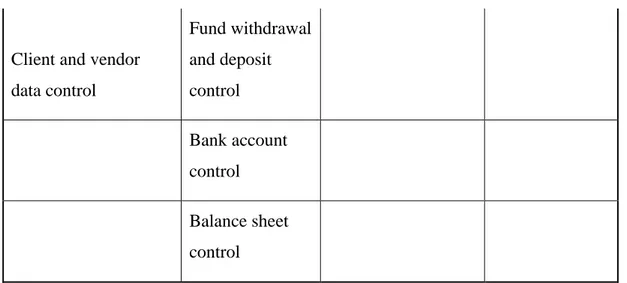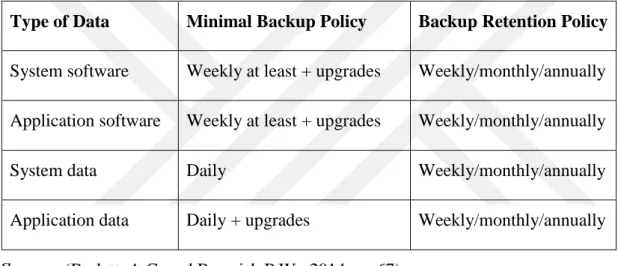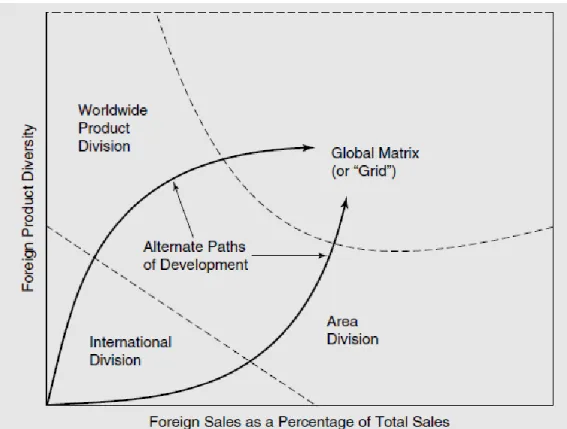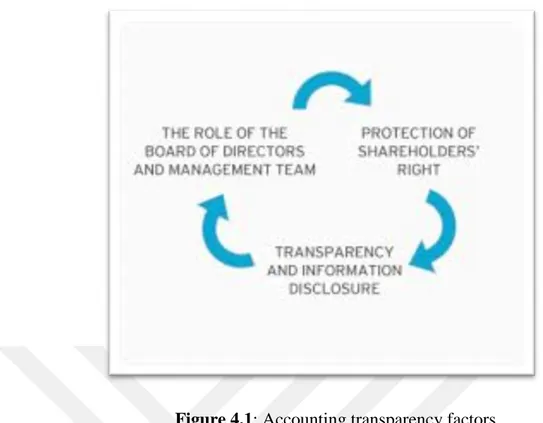i T.C.
ISTANBUL AYDIN UNIVERSITESY INSTITUTE OF SOCIAL SCIENCES
THE EFFICIENCY ANALYSIS OF ACCOUNTING TRANSPARENCY AND REALISATION ON IAS 1 PRESENTATION OF FINANCIAL STATEMENTS
WITHIN TRANSNATIONAL MANAGEMENT
THESIS
Ozlam TAHIRLI (Y1512.130034)
Department of Business Business Administration Program
June 2017 Thesis Advisor:
iii FOREWORD
Transparency issue is considered as one of the main problems worldwide and it is times more difficult when the company is big and transnational. Due to this reason, I preferred to choose this subject for the thesis.
This purpose of this thesis is to show how important to implement various standards and how it is times more effective when one organisation applies various standard at the same time.
I would like to thank Assist. Prof. Hülya Boydaş Hazar for all her suggestions and guiding which is highly appreciated by me. I would also like to thank my family who is always by my side.
iv TABLE OF CONTENTS Page FOREWORD………..………....….. iii TABLE OF CONTENTS... iv LIST OF TABLES……….……….…. vi
LIST OF FIGURES……….………..….… vii
ABSTRACT………...….… viii
ÖZET………..…..…. ix
1. INTRODUCTION... 1
1.1 Purpose of Thesis……….……..…...… 1
2. IAS 1: PRESENTATION OF FINANCIAL STATEMENTS………..……. 3
2.1 IAS 1 Definition……….….. 3
2.2 IAS 1 Principles and Requirements…...……….… 3
2.3 Set of Financial Statements Required by IAS 1………..……….…… 4
2.4 IAS 1 Purposes and Influences……… 11
2.5 IAS 1 Implementation……… 13
3. TRANSNATIONAL ORGANISATION... 16
3.1 Transnational Organisation Definition….….………. 16
3.2 Transnational Organisational Accounting Structure……….……. 20
3.3 Transnational Organisational Policies and Procedures Relating to Accounting Compliance………...……….………... 24
3.4 Transnational Organisational Development and Integration………….… 34
3.5 Importance of IAS 1 for Transnational Organisations……….….. 38
4. INTERNATIONAL ACCOUTNING TRANSPARENCY AND DISCLOSURE……….……….……...….. 44
4.1 International Accounting Transparency and Disclosure Definition….…. 44 4.2 International Accounting Transparency and Disclosure Priorities……… 50
4.3 International Accounting Transparency and Disclosure Significance..…. 51
4.4 IAS 1 Application to Corporate International Accounting Transparency and Disclosure Policy.………..……..………. 54
4.5 Factors Influencing International Accounting Transparency and Disclosure………...….……. 55
4.5.1 Costs and Risk……….. 55
4.5.2 Public’s Right to Know Good Governance……….. 56
4.5.3 Rights of Public Servants………..……... 56
4.5.4 Effective Public Administration………...…… 57
4.6 Benefits of International Accounting Transparency and Disclosure..…... 59
4.7 International Accounting Transparency and Disclosure Failure….…….. 63
5. PARTIES AFFECTED BY INTERNATIONAL TRANSPARENCY AND DISCLOSURE... 67
v
5.2 Government and its Entities……….. 68
5.3 Company Board of Directors……….……..….… 70
5.4 Company Management………....…. 71
5.5 Company Employees………...…. 72
6. APPLICATION... 74
6.1. Introduction of the Company……….………...…… 74
6.2 Company History and Structure……….………..…..74
6.3 Integration of Transnational Organisations into Accounting Transparency and Disclosure………..… 74
6.4 Single Standard Implementation and Realisation…….………….…… 84
6.5 Factors of Single Standard Implementation and Realisation…….….... 86
6.6 Benefits of Single Standard Compliance……….….. 88
6.7 Failure of Single Standard Implementation and Realisation……….… 90
6.8 Additional Actions for International Transparency and Disclosure Realisation………... 94
6.9 The Mechanism of International Transparency and Disclosure Realisation... 98
7 CONCLUSIONS AND RECOMMENDATIONS... 118
7.1 Practical Application of This Study…………..………….………….. 118
7.2 Recommendations for Realisation of International Transparency and Disclosure Procedures ………... 123
REFERENCES... 134
vi
LIST OF TABLES
Page
Table 2.1: Statement of financial position sample ……..………..…..…... 5
Table 2.2: Statement of comprehensive Income sample ………..….... 6
Table 2.3: Balance sheet sample……….……….….……...…. 8
Table 2.4: Statement of cash flows sample ….………..………... 9
Table 3.1: Duty division.………..………...… 25
Table 3.2: Fund authorisation sample.……….…...… 26
Table 3.3: Backup System Procedures sample.…………..…....……….…...… 33
Table 3.4: Backup System Targets.…………..…....……….. 34
Table 5.1: Most and least transparent companies....……….……...…...… 69
Table 5.2: Functions of the Boards.……….…………..……….… 70
Table 6.1: Examples of differences between IFRS and U.S. GAAP.……….… 76
Table 6.2: Examples of differences between IFRS and U.S. GAAP.……….… 77
Table 6.3: Transparency realisation stages.……….…...… 94
Table 6.4: Payment history……….…………... 106
Table 6.5: Extract from payment history……….. 106
Table 6.6: Extract from payment history……….…. 106
Table 6.7: Extract from payment history……….…. 107
Table 6.8: Extract from payment history……….…. 107
Table 6.9: Extract from payment history……….…. 107
Table 6.10: Extract from payment history………...…. 107
vii
LIST OF FIGURES
Page
Figure 2.1: Worldwide share scale ……….… 15
Figure 3.1: Top transnational companies sales statistics ……….………... 18
Figure 3.2: Company structure model ………….……….... 20
Figure 3.3: Financial/accounting division model ………..…………... 22
Figure 3.4: Transnational organisations entity connection………... 23
Figure 3.5: Transnational organisation’s barriers and targets.…….…... 36
Figure 4.1: Accounting transparency factors ………..….………..…. 52
Figure 4.2: Transparency view from perspective of company and investors…..… 53
Figure 4.3: Influences affecting transparency ………..….….. 56
Figure 4.4: Corporate Governance cycle ………….……….….…... 63
Figure 5.1: Transparency effect..……….……….……….….….. 67
Figure 6.1: 1st phase activities.………..……….………..….…….. 78
Figure 6.2: 2nd phase activities ……….………..…………...…. 80
Figure 6.3: Money laundering forms..……….….……….….…….. 81
Figure 6.4: 3rd phase activities..……….……….…….……….... 83
Figure 6.5: 4th phase activities ……….…...………….... 84
Figure 6.6: Algorithm of applied solution ……….….…………...… 100
Figure 6.7: Algorithm of applied solution ………..…….…..……….... 101
Figure 6.8: Algorithm of proper management in scope of transparency realisation…....……….... 103
Figure 6.9: International transparency mechanism (single entity)………... 114
Figure 6.10: Organisation departments scheme and integration (application)…... 115
viii
THE EFFICIENCY ANALYSIS OF ACCOUNTING TRANSPARENCY AND REALISATION ON IAS 1 PRESENTATION OF FINANCIAL
STATEMENTS WITHIN TRANSNATIONAL MANAGEMENT ABSTRACT
Accounting standards are counted to be the force that guarantees the proper compliance of a company to the accounting principles. Each standard has a specific role in the accounting processes, however each company has its own attitude to all of them. This attitude depends on number of factors, such as the scale of company, region of activities, its own principles and etc.
At the time when a world is living through globalisation and integration, international companies are ruling companies in the world as they cover big territories and involve many people. In order to be able to properly manage such companies the management has an obligation to create certain standards inside the companies that would fit its entities all around the world. These standards are playing the role of a unique and universal “language” within certain sphere of activities. Respectively, the company has to deal with its accounting issues as well and determine its own standards within the company which at the same time have to fit the international accounting standards as well. While each company has to follow these standards in full power, in reality it rarely happens and most of the time companies live through number of gaps. The compliance of standards is the liability of the company management and it directly affects both image and prosperity of the company.
Below we will observe all the issues that a company faces while trying to comply one of the most important accounting standards, IAS 1 and what happens when a standard is mistreated. As a result of gaps in standard compliance we will see the effect of management mistakes on the company image and performance. Besides that, we will overview the experience that was gained in an international construction company regarding standard compliance and elimination of transparency and disclosure failure, its consequences which will show what actions should be taken in order to keep the image and performance of a company on top.
Keywords: Accounting, IAS 1 Standards, Transparency, Transnational Organizations.
ix
MUHASEBE ŞEFFAFLIKININ UYGULANAN MALİ TABLOLARIN SUNUMUNA İLİŞKİN UYGULAMA FAALİYETLERİNE İLİŞKİN
ETKİNLİKLER İLE İLGİLİ ANALİZ
ÖZET
Muhasebe standartları, bir şirketin muhasebe ilkelerine uygunluğunu güvence altına alan bir güçtür. Her standardın muhasebe süreçlerinde belirli bir rolü vardır, ancak her şirketin her biri kendi tavrına sahiptir. Bu tutum, şirket ölçeği, faaliyet bölgesi, kendi ilkeleri ve benzeri faktörlerin sayısına bağlıdır.
Bir dünya küreselleşme ve entegrasyon vasıtasıyla yaşarken, uluslararası şirketler, büyük toprakları kapsadığı ve birçok insanı içerdikleri için dünyadaki yönetici şirketler. Bu tür şirketleri düzgün bir şekilde yönetebilmek için, yönetim, şirketlerin tüm dünyaya uyacak belirli standartlar oluşturma yükümlülüğüne sahiptir. Bu standartlar, belirli faaliyet alanlarında benzersiz ve evrensel bir "dil" rolü oynamaktadır. Şirketin her biri aynı şekilde muhasebe konularıyla uğraşmak ve şirket içinde kendi standartlarını belirlemek ve aynı zamanda uluslararası muhasebe standartlarına uymak zorundadır. Her şirket bu standartları tam güçle takip etmek zorunda iken, gerçekte nadiren olur ve çoğu zaman şirketler boşluklar yaşar. Standartların uyumu şirket yönetiminin sorumluluğudur ve şirketin imajını ve refahını doğrudan etkiler.
Aşağıda, bir şirketin en önemli muhasebe standartlarından birine uymaya çalışırken karşılaştığı tüm sorunları, IAS 1'i ve bir standart kötü muamele gördüğünde ne olacağını gözlemleyeceğiz. Standart uyumluluktaki boşlukların bir sonucu olarak yönetim hatalarının şirket görüntüsü ve performans üzerindeki etkisini göreceğiz. Bunun yanında, bir uluslararası inşaat şirketinde standartlara uyma ve şeffaflığın ortadan kaldırılması ve ifşa hatasının ortadan kaldırılması konusundaki deneyimine bir şirketin imajını ve performansını en üst seviyede tutmak için ne tür önlemler alınacağını gösteren sonuçlara genel bir bakış yapacağız.
1 1. INTRODUCTION
1.1 Purpose of Thesis
The purpose of this thesis is first of all to show all the issues and factors which an international company lives through by trying to fit the accounting standards at all of the stages of company progression. By showing these factors we will observe the main barriers within the standard that the company meets and how they should be treated in order to keep the company both fitting the accounting standards and continuing its own internal processes.
Once we determine the tough points of IAS 1 implementation into the company’s accounting processes we can find alternative solutions that company map apply. As per the experience of international construction company we will be able to see how they managed to fix their issues within the company, including such important ones as transparency and disclosure failure. Besides that, it is an important issue to fully understand the purposes of the international accounting standards and recognise the benefits that it may provide to the company. While each country has its own accounting standards, other countries are obligated to understand and comply the standards of other countries. International accounting standards eliminate this issue by providing with single stated standard that is internationally accepted, tested and recognised. Respectively, international accounting standards play role of universal solution for the management of international companies. When a company understands and recognises this significance it is ready for full implementation of all standards.
This thesis will show the true purposes of standards and how they actually benefit companies. On the sample of transnational management, we will be able to observe how this factor is fully explored and recognised.
Another purpose of this thesis is to show how non-compliance to the standards raises internal issue of the company and what are the symptoms of such issue. On the sample
2
of construction company, we will be able to see how the company had passed through employment crisis due to the non-compliance to the IAS 1. This crisis brought up to temporary termination of all the construction processes that put the whole work of the company under the risk. However, this crisis became a lesson for the company that had to take a deep analysis of the situation in order to fix all the gaps in shortest possible period of time.
The final purpose of this thesis is to show how efficient international accounting standards are realised on the case of transnational management, the reasons of the outcome, its factors and consequences. It is important to determine the difference of accounting standards realisation between single-country based and international companies, the factors that influence these processes and where the differences occur. Also, we will observe the outcome of the differences and be able to build up a mechanism that will fully show what an international company should take as an instruction while complying IAS 1 and eliminating all the ways to transparency and disclosure failure possibility. Such kind of mechanism would guaranty an efficient IAS 1 compliance and accounting transparency and disclosure, which is a key for prosperous company management and performance.
3
2. PRESENTATION OF FINANCIAL STATEMENTS
2.1 IAS 1 Definition
International Account Standard 1 was primarily presented to the society in March of 1974 and had full name as Disclosure of Accounting Policies. This title bares basic and main principle of this standard despite further changes in it that followed during next years. Overall ISA 1 lived through 22 changes with last one that happened in December of 2014 and second title change that happened in September 2007 when the standard full name became IAS 1 Presentation of Financial Statements. (Edmonds, T., Edmonds, C., McNair, F. and Olds, P., 2012, pg.90-103)
IAS 1 Presentation of Financial Statement is a standard that states all the conditions and requirements settled before the company management regarding financial statement construction, provision, content and presentation. IAS 1 covers all required documents, forms, tables and statement that should be included in the provided statement. IAS 1 guarantees the truthfulness of provided information when a company complies all its requirements in full power. IAS 1 is an unavoidable requirement for company willing to be internationally recognised and accepted. IAS 1 is the very first standard among all other accounting and financial standards which is explained by its and unavoidable significance as IAS 1 is the base and starting point of accounting standards complying processes.
2.2 IAS 1 Principles and Requirements
The main principle of IAS 1 is providing true and transparent disclosure of all required information to the related parties. The related parties may be primarily and secondary related ones. The primarily related parties are active shareholders and company
4
members, i.e. employees and management. The secondary related parties are media and public in general, i.e. possibly future shareholders.
Once a company fully complies the IAS 1 requirements, it fulfils the principles of the standard in whole. It is obvious that shareholders and company members have right to get wider scope information about the financial position of the company, however it does not approve any false information provided to the media and public. In other words, the public and media may not be provided with deeply detailed information about the financial statement of the company but general numerical information provided to them must be true and transparent.
IAS 1 is the standard that defences the rights of shareholders and public in general by forcing the companies to provide transparent information and widest disclosure that is applicable in the frames of company privacy as well. IAS 1 principles do not harm the confidentiality of the company however it states that the confidentiality frames of one company may not conflict with the right of shareholders on information disclosure. In other words, a company may not avoid information sharing with its shareholders when it refers to their dividends which is directly connected to the financial statements of the company, by approving it with company confidentiality policy. IAS 1 made the process of dividend sharing among shareholders transparent and realised the process of the financial disclosure. As we can see per history IAS 1 had a history of more than 40 years and it is constantly gets upgraded that proves its significance and need. (Best, N., Stiff, P., Astranti, 2014, pg.100-112)
Before observing the technical requirements of IAS 1 first of all we should have a deep analysis on the meaning, reasons of these requirements, i.e. see the roots of statement provision requirement. IAS 1 main requirement form the companies is the responsible use of all funds, income that company gets, its usage and division. A company should first of all understand that shareholder/stockholder is not just a party that buys some shares and keeps them till certain period, first of all he/she is investor that automatically gives him right to know what truly happens inside the company, what its strong and weak points are, which risks it ever had or may have in future. In other words, a company has to have a “professional respect” to its shareholders and make sure that the funds that are invested by them are fairly managed. Meanwhile shareholders may not be involved in all daily processes inside the company and the
5
instruments that provides them with all required and sufficient information are financial statements of the company. Correspondingly by providing information to the shareholders the company is responsible to provide truthful and transparent information.
Once a company fully understands its responsibility before the shareholders it would be able to keep all its accounts in proper position. Respectively transparency and disclosure realisation would be correctly applied as well.
Another requirement of IAS 1 is to provide understandable information to the shareholders and public, i.e. information that would be clearly understood by its users. Due to this IAS 1 identified all the statement and its proper construction principles. At each upgrading IAS 1 gets mew changes for better understanding of financial information that is provided to shareholders, with deeper explanations and appendixes.
2.3 Set of Financial Statements Required by IAS 1
As it was stated above a company has certain standard for information provision as per IAS 1.
Below we can see the list of required documents that a company should provide to its shareholders.
1. a statement of financial position as at the end of the period
This document has to include all eligible information about assets, liabilities and equity respectively.
In assets part it should mention all below units:
Current assets: cash and its equivalents, accounts receivable, prepaid expenses, securities, inventory, and other liquid assets.
Fixed assets: all units with corresponding depreciation
Current (short-term) liabilities: payables and expenses
Long-term liabilities: debts and etc.
Equity: common stock and earnings (Radebaugh L.H. and Gray S.J. (2002). p.19-33, 104-125, 347-364)
As per the statement of financial position the user may access information about how much money is cumulated as equity for shareholders.
6 sample:
7 Table 2.1: Statement of financial position sample
Statement of Financial Position December 31, 2015 Assets Current Assets Cash $ 32,800.00 Inventory $ 39,800.00
Total Current Assets $ 72,600.00
Fixed Assets Leasehold Improvements $ 100,000.00 Accumulated Depreciation $ -2,000.00
Total Fixed Assets $ 98,000.00
Other Assets Trademarks $ 20,000.00 Accumulated Amortization $ -8,000.00
8
Total Other Assets $ 12,000.00
Total Assets $ 182,600.00 Liabilities Current Liabilities Accounts Payable $ 49,000.00 Accrued Expenses $ 1,000.00
Total Current Liabilities $ 50,000.00
Long-term Liabilities $ 25,000.00 Total Liabilities $ 75,000.00 Owner's Equity Owner's Equity Common Stock $ 20,000.00 Retained Earnings $ 87,600.00
Total Owner's Equity
$
107,600.00 Total Liabilities and Owner's
Equity
$
9
Source: (Edmonds, T., Edmonds, C., McNair, F. and Olds, P. (2015) pg.54-60) 2. statement of comprehensive income for the period
This document shows all information about the revenue and expenses and what net income and comprehensive income is after all movements.
sample:
Table 2.2: Statement of comprehensive income sample
Income Statement
For the Year Ended Dec 31, 2015
Revenues Merchandise Sales $ 24,800.0 0 Music Lesson Income $ 3,000.00 Total Revenues: $ 27,800. 00 Expenses Cost of Goods Sold $ 10,200.0 0 Depreciation Expense $ 2,000.00
10 Wage Expense $ 750.00 Rent Expense $ 500.00 Interest Expense $ 500.00 Supplies Expense $ 500.00 Utilities Expense $ 400.00 Total Expenses: $ 14,850. 00 $ 12,950. 00
Comprehensive Income Statement
For the Year Ended Dec 31, 2015
11 Net Income $ 12,950. 00 Other Comprehensive Income
Unrealized gain on available
for sale securities
$ 1,000.00
Unrealized loss on held to maturity securities
$ -500.00
Foreign currency adjustments
$ -100.00 $ 400.00 $ 13,350. 00
Source: (Edmonds, T., Edmonds, C., McNair, F. and Olds, P. (2015) pg.54-60)
3. a statement of changes in equity for the period
This statement shows the details of what equity contains as per the income and expenses during the year.
12 Table 2.3: Balance sheet sample
sample: Balance Sheet Dec 31, 2015 Asset s Current Assets Cash $ 32,800.00 Accounts Receivable $ 300.00 Prepaid Rent $ 1,000.00 Inventory $ 39,800.00
Total Current Assets
$ 73,900.00 Long-term Assets Leasehold Improvements $ 100,000.00 Accumulated Depreciation $ -2,000.00 $ 98,000.00
13
Total Long-term Assets
$ 98,000.00 Total Assets $ 171,900.00 Liabilities Current Liabilities Accounts Payable $ 49,000.00 Accrued Expenses $ 450.00 Unearned Revenue $ 1,000.00
Total Current Liabilities
$ 50,450.00 Long-term Liabilities $ 99,500.00 Total Liabilities $ 149,950.00 Owner's Equity Owner's Equity Retained Earnings $ 11,950.00
14
Common Stock
$
10,000.00
Total Owner's Equity
$
21,950.00
Total Liabilities and Owner's Equity
$
171,900.00
Source: Edmonds, T., Edmonds, C., McNair, F. and Olds, P. (2015) pg.54-60
4. a statement of cash flows for the period.
This statement shows all cash movements of company as this account is very sensitive for each company and bares necessary information
sample:
Table 2.4: Statement of cash flowssample
Statement of Cash Flows Dec 31, 2015 CASH FLOWS FROM OPERATING
ACTIVITIES
Net income $ 12,950.00
Adjustment to reconcile net income to net cash provided by operating activities:
15 Increase/decrease in current assets Accounts Receivable $ -300.00 Inventory $ -39,800.00 Prepaid Expenses $ -1,000.00 Increase/decrease in current liabilities Accounts Payable $ 49,000.00
Accrue expenses and unearned revenues $ 1,450.00 NET CASH PROVIDED BY OPERATING ACTIVITIES $ 24,300.00
CASH FLOWS FROM INVESTING ACTIVITIES
Purchase of property and equipment $ -101,000.00
NET CASH USED IN INVESTING ACTIVITIES $ -101,000.00
CASH FLOWS FROM FINANCING
ACTIVITIES
Proceeds from line of credit $ -
Payments on line of credit $ 10,000.00
Proceeds from long-term debt $ 99,500.00
16
NET CASH PROVIDED (USED) IN FINANCING
ACTIVITIES $ 109,500.00
NET INCREASE (DECREASE) IN CASH $ 32,800.00 BEGINNING CASH
BALANCE $ -
ENDING CASH BALANCE $ 32,800.00
Source: (Edmonds, T., Edmonds, C., McNair, F. and Olds, P., 2012, pg.90-103)
5. notes, comprising a summary of significant accounting policies and other explanatory information
6. a statement of financial position as at the beginning of the earliest comparative period when an entity applies an accounting policy retrospectively or makes a retrospective restatement of items in its financial statements, or when it reclassifies items in its financial statements.
Depending on the different company policies the mentioned above statements may have different names, which still has to have the same content of information as the statements above do.
While reporting to the shareholders a company has an obligation to provide with full information including each and every above mentioned statement which is considered as responsibility of company management. Absence of any of mentioned statements is not accepted and would be valued as IAS 1 abuse. In further units on examples we will review how these reports actually look and that will deeply explain their significance by showing their full content.
Many companies may also provide some additional documents while reporting to shareholders as per below stated:
1. External information about company performance, such as journal articles and public reviews, environmental reports and explanatory letters, internal and external audit process, result information
17
2. List naming the funding entities, calculation of finally ratios.
3. The company’s resources that are not recorded in the statements that are permitted as per IFRS. (Radebaugh L.H. and Gray S.J. 2014, pg.30-55)
Environmental reports may be some annual reports, reviews of feedback from the local entities where a company operates and which should be responded by the company management in order to resolve the issue.
At the same time when a company lives through tough periods the company management may wish to present some explanatory letter to its shareholders. Usually, such letters include reasons and explanations why a company has some certain issue and proposals of future changes, possible forecast of company future, action and business plans. All these documents are not required by IAS 1, however there are welcomed and a proof of company’s responsibility recognition and deduction.
By listing the funding, investing entities the company usually tries to prove the performance success of a company, showing the interest of other entities in their business. The same purpose is hidden in provision of financial ratios, as the numbers with positive meaning would motivate the shareholder and play an advertisement role for a company. This action would help a company to gain more shareholders and interested parties.
There is a negative side of additional information provision, as in case a company stops provided with additional information it may be considered by shareholders that the company I has certain issues and simply does not have certain achievements to share with its shareholders. This is the reason why companies as per precedent are very sensitive about provision of additional information and usually limit themselves with standard newsletter.
2.4 IAS 1 Purposes and Influences
The purpose of IAS 1 is to develop certain system or standard within each company that would ensure proper provision of information to shareholders and all involved parties. Each company has its own internal procedure and policies that determines the route how a company acts. At the same time company and its management are only
18
parties that have an access to full information about their company and respectively the may provide some information or not. In order to have an outside mechanism that would make the companies obliged to provide necessary information to the shareholders IAS 1 made a frame of significantly important and needed information that each company has to provide to its shareholders. Otherwise the company would be counted as non-compliant to the international accounting standards and would not be recognised as a reliable side. The main purpose of IAS 1 is to keep all necessary information for shareholders transparent and proper in order to avoid misunderstanding and failure. IAS 1 ensures fair conditions of business organisation between one company and its shareholders. (Radebaugh L.H. and Gray S.J. 2014, pg.30-55)
At the same time IAS 1 is influencing the whole company by setting certain standards and requirements before them. The company feels responsibility for its actions and it is not related to only reporting period, it affects their daily business life as they all know that at the end of reporting period they would need to answer for this actions. From the other side they may not keep their company with transparent but poor performance as this will also affect the decisions of shareholders. IAS 1 influences the company decision making processes which lie in the very centre of the company. The decision making of each company is tightly connected with all strategical processes of the companies, including business plan development, policy construction and new market integration. Respectively it means that IAS 1 influence both administrative and operating departments of the companies. In other words, IAS 1 is the standard that makes company act the most proper and transparent way both inside the company and in relationship to its shareholders.
It is the top management’s duty to follow IAS 1 requirements as it falls under strategical decisions category which is the management’s responsibility. Non-compliance to the standards can directly bring up to the loss of shareholders, decrease of the share prices in the stock exchange market, harm of company image, revenue loss, high employment liquidity and other issues that can bring up to irrecoverable results. As per precedent of other companies during last 40 years the companies are aware of possible issues that they may experience in case of standard failure and due to this they value the option of IAS 1 non-compliance as the worst possible scenario.
19
It is a known fact that companies have to make daily efforts in order to gain the name of company that follows the IAS standards and especially IAS 1, however the compliance of the standard brings up to many benefits, including main one, revenue rise. This is a driving power for the company management once they make decisions, including employee hiring and procurement processes. The responsibility that falls on the management makes them be very sensitive in each and every decision making within the company, so that it does not impact the reports that will be submitted to shareholders as per IAS 1 requirements on constant basis. (Rzayev,Q. 2007, pg.45-57)
Below as sample we may see some processes that get influenced by IAS 1. (Rzayev,Q. 2007, pg.60-76)
IAS 1 requests a statement of comprehensive income for the period from the company as one of its requirements
A statement of comprehensive income includes all expenses, including operational wages
The top management of company is aware that as per IAS 1 they will need to provide with the statement of comprehensive income and due to this they should
be very attentive with the employees who realise all the functions that may be reflected in the statement
20
As management requires fair and responsible employees, Human Resources department is responsible to fin and employ eligible professionals` for
corresponding positions.
21
When a Procurement department with professional employees, choses a supplier it knows that all the processes should be done with high level of transparency, including tenders if necessary. Procurement department keeps in mind, that the wages would be reflected in the statement of comprehensive income, and it will
be controlled by management
Once a supplier is chosen and a contract is signed, the Operational department is aware that all the expenses should be adequate and reasonable, as it will affect
the statement of comprehensive income. Due to this, it will be controlled by management directly
As we may see in the table 5, all the processes inside the company are interrelated and this connection gets more sensitive because of IAS 1. This sample showed only one small part of IAS 1 requirements that make us recognise the significance of this standard in whole. Due to this we may state that IAS 1 influences the whole company in general and certainly bring progress to the company.
2.5 IAS 1 Implementation
Once a company prepares all the necessary reports it should enclose them with the shareholders. Nowadays this process happens easier than it was before, as just emails get sent to the corresponding parties.
The reporting period should cover 1 year and be presented at the end of each year, however this year may not be a calendar year. It is a known fact that most of the times companies have the financial year, which rarely starts and ends as a calendar year in order to escape information traffic and work load issues. However, if a company decides to change its financial year and presents the reports earlier or later than it usually did, it should present an additional appendix explaining the change of reporting period beforehand and in addition provide a report covering the difference period. In
22
case a company mistreats this rule it is counted as IAS 1 abuse. Besides that, in the comments that company provide to the shareholder comparative analysis should also be included. This analysis should show all the rises and falls in different categories correspondingly. (Radebaugh L.H. and Gray S.J. 2014, pg.67-89)
In case a company decides to make internal changes such as changing the classification of financial statement items, it also should mention it in appendix, so that shareholders may detect the items properly for their reference. IAS 1 insists on transparent and proper explanatory report showing all the reasons why the classification change happened within the company. This was the shareholders may be understanding true reasons why a company decides to make certain changes.
Besides that, all information should be introducing in consistent way, as it is mentioned in IAS 1 guide book.
In case a company does not comply to any of International Accounting Standards, including IAS 1 it would be defined a non-compliable to standards company and would fall out of Stock Exchange.
If we look at IAS 1 and its guide, we can access all information about how company should prepare all the reports and what are the full list of requirement will all the details. However, IAS 1 means much more for a company than just a guide for reporting to shareholders. This standard bares critical points of each company and its compliance makes a company to enter a new stage of professional business making. This standard does not relate to the accounting area of a company only, it influences whole company and its route in general. When a company complies to International Accounting Standards and enter Stock Exchange it becomes visible and valuable for whole world and immediately become capable to enter new financial markets. From that moment any capable share buyer may become a part of this company by investing in its business. In whole this process IAS 1 play is a standard that makes a company to provide certain information to the shareholder. However, each and every company has hard time in preparing such reports, it should clearly value this process as key to new market integration. (Fraser, L.M. and Ormiston, A. (2010) pg.55-102)
By providing such reports to the shareholders it may either lose the shareholders or sell more shares to existing shareholders and gain new shareholders. This part totally depends on the performance of the company and IAS 1 is a standard that will show the
23
results to shareholders. Each company targets to get the best results in their performance so that it would be reflected in the IAS 1 reporting and would attract new shareholders that will result in the rise of the share price. However, in case c company shows poor performance it would also be reflected in IAS 1 and respectively may end up with loss of shareholders and decrease of share prices. The companies are very sensitive about their performance as in IAS 1 it is very hard to hide the poor sides of the company, however it is still possible and IAS 1 constantly work on its development and upgrading. Despite all the requirements and standard of IAS 1 the companies still find ways how to cheat on their shareholders in indirect ways and this proves how IAS 1 is important for both sides and why its compliance should be carefully watched. (Radebaugh L.H. and Gray S.J. 2014 pg.24-56)
In order to show the significance and scale of share floating in the world, we can take a look on below map of free-float equity market capitalization.
Figure 2.1: Worldwide share scale Source: (Rzayev, Q. 2015, pg.66)
As we may see the share market occupies almost whole world and this is a ruling power that motivates the companies to show high performance in their areas. Each
24
company tries to become a part of world share net and IAS 1 is the standard that they have to deal with in order to achieve their goals and targets.
25 3. TRANSNATIONAL ORGANISATIONS
3.1 Transnational Organisation Definition
Transnational organisations are the organisations that operate in more than 1 country by locating there their maintenances. It does not particularly consider that the organisation will have the same name in each organisation or even locate any office. Transnational organisation may simply hire some other company to work for them or invest in some company for service provision.
Before overviewing the transnational organisations in details we should first of all determine the main core differences between the 4 types of the organisations that all practice business in various countries as the same time.
Below we may mention above 4 types of organisations: International organisations:
International organisations realise importing and exporting of either raw materials, spare parts of ready products from and to different countries but they do not make any business in those particular countries. International organisations practice the pure trade of needed materials, products but is not directly interested in the business market of each country from where they are connected.
Multinational organisations:
These organisations actually do have investment in various countries and they differentiate their product as per demand of each market. Such organisations prefer to study the tastes and needs of each market in order to present the best buyable product to the potential buyers.
26
Global organisations are well known for presenting single type product to all markets where they participate. Such organisations are usually famous for their brands that are strongly demanded in any market they wish to participate in. Franchising type of activities are mostly commonly used by global organisations.
Transnational organisations:
Transnational organisations are considered to be a more complex structures with the various types of services that they may provide with branches and entities in various countries. Unlike other types of the organisations the transnational ones mostly prefer to invest into the companies that would be realising certain activities. At the same time such companies may change their profile and chose to invest into totally different type of company that would realise type of service that was not realised before. The strongest managerial task in transnational organisations is being able to keep all entities together as each entity is free to choose the internal managerial functions and tasks, respectively fitting the frames and standards of the transnationals organisations. Besides that, the transnational organisation does not have any headquarter in the way other types of organisations do, the headquarter for transnational organisation is considered to be a centre where all reports, statements, statistics and information is gathered with purpose of modifying the organisation in a whole.
Legally transnational organisations are treated like regular companies and the taxation does not vary for them than from any other companies and each entity is observed with legal legislation of each country. As it was mentioned before the transnational organisation is more considered as a certain union that has main purpose of development and better business making. In addition, the transitional organisations target to implement the least legal integration in to their business, however, it does not mean that the companies have poor corporate governance and standard implementation. In opposite, the transnational organisations are very sensitive about their corporate governance and practice constant development of standards and procedures, that is from one side considered as requirement which will be explained in next units.
Unlike other organisation types like global and multination organisations, transnational organisations have the highest responsiveness power to the changes in the markets they are involved in. It is a usual case that a company makes certain efforts
27
in analysing the market before entering it, however transnational organisations constantly hire analytic consultancy companies that on constant basis analyse the market and give forecast to their clients. With their help a transnational organisation is capable to increase or decrease its investments in certain companies. (Barlett, A.C and Beamish P.W. (2014) pg.275-311, 541-591, 625-642)
Due to the complex structure the most transnational organisations are members of various stock exchange markets and prefer to sell shares to the potential shareholders for a more adequate and transparent management. Respectively, the shares are sold not by each entity or branch but by the whole transnational organisation which makes the input of each entity/branch highly valuable for the organisation.
There are various reasons why an organisation may wish to become a transnational one and most of them fall under below categories:
1. New market opportunity
2. Less cost (labour cost, raw material cost, other wages, taxes)
3. Simpler legal procedures (Litneva N,A. and Malyavkina 2006, pg.10-27)
Below we may see top transnational companies in the world along with their sales figures as off year 2011.
28
Figure 3.1: Top transnational companies’ sales statistics Source: (Skousen C.J and Walter L.M 2012, pg.30-48)
As per precedent the transnational companies are counted to be more reliable due to their image and international practice and their appearance in a new country bares success from the very beginning, however in certain cases there may be some factors due to which the companies may not wish to open there any entity or to invest in other company.
One of such samples in Starbucks company that still denies to open a company in Italy. In 1973 Starbucks company had analysed the market of Italy and the decided that Starbuck company should not open there any shop or sell any products for long period due to big competitive power inside the company. All of the drinks that Starbucks company presents to their customers were primarily invented in Italy which can easily be seen in the titles on the drinks and whole world accepts those titles as well. Italy is a country that has huge number of small coffee shops all over the country that provide
29
with various coffee drinks and that are widely accepted, recognised and valued by the users. As per analysis the Starbucks company would not be used by the local customers as their services would not be new or special to them. In 2016 Starbucks made another country analysis and decided that they may open a pilot company in early 2017 in Milano in order to test if the company would have any success. The reason why shop Milano was chosen as pilot one was due to huge number of tourists in that city. In other words, Starbucks company still recognises the fact that local people would not be interested in the coffee products of the company and target tourists mainly, that would value Starbucks as a familiar to them brand. However, in the end of 2016 one of the leading newspapers of Milano, Milanotoday announced the decision of Starbucks to postpone the coffee-shop opening till the middle of 2018, which is still not a certain decision.
Below we may see short part of the article which was published by Alessandro Rovellini and shared by numerous sources: (Nurunnabi, M., 2006, pg.27-90)
30
As we can see in the article the coffee-shop opening of Starbucks company had already been postponed for several times and it may seem that the reason of this uncertainty is just the competitiveness power of Italian market, however the roots of this issue lie much deeper. The main reason why Starbucks is not sure about the success in Italy are the cultural and historical factors of the country. Italy already has all the services and products that Starbucks want to sell in the country and it make their goods less attractive for the users. It may seem that Starbucks should not have succeeded in Turkey as well, due to the fact that coffee from the beginning was taken to whole Europe from Turkey. However, in Turkey Starbucks has been succeeding for many long years. There appears a question why there is a risk of failure for Starbucks company in Italy. The reason is that unlike Turkey Italy had developed big number of various coffee drinks that are very popular in the country itself, while in Turkey such drinks have not been widely provided by local coffee-shops. Besides that, Italy has several world leading companies that traditionally been working on inventing and developing numerous machines that prepare different coffee drinks. These companies had developed a brand name that is recognised all over the world, such as Illy, Lavazza, Gaggia, Bialetti.
As we can see there are various reason why one company may decide to integrate or not into one country which bares big analysis behind it.
3.2 Transnational Organisational Accounting Structure
Once a company is a transnational company it has to have a well-developed system inside the company so that all entities interact with each other and provide the needed services. The details of the system depend on the type of the company and services that it provides. However, it a known fact that any company no matter how big it is needs a well-functioning accounting system.
Transnational organisations respectively have a more complicated internal system than a local companies do and it relates to accounting department as well. Unlike local organisations, the transnational ones have to deal with legislations of different countries, including tax legislation as well. Besides that, the transnational companies have to develop such system where all entities of an organisation would have to tightly interact with each other a have a well-functioning communication system.
31
Before determining how accounting structure should look in transnational organisations we should observe the look in regular companies and what are their main differences. As a single-country based company does not have to deal with different entities from other parts of the world and different legislations, the structure of such company would look a simple scheme. However, this scheme has many implications in reality and the implementation of all duties consider hierarchic relations between the parties. (Skousen C.J and Walther L.M (2012) pg.30-48)
Below we may see how a company’s accounting system should look when it is properly constructed.
Figure 3.2: Company structure model
Source: (Warren, C.S., Reeve, J.M. and Duchac, J. (2013). pg.100-112) As we can see on the top of an organisation there is Board of Director who are responsible for the main strategic decisions of the company and shoes the route of company the way it start and should keep going on. The Board of Directors are the main shareholders of the company, which means that when an individual or company buys certain percentage of shares of certain company it becomes the member of Board of Members.
The Board of Members have only one person from the company who they communicate with and who directly reports to them, is responsible for Board of Members meeting organisations and request implementations. That person is Chief
32
Executive Officer (CEO), who is actually counted to be the one who passes the decisions and instructions of Board of Members to all the company and that is why he/she is considered as “head” person in the company. We should keep in mind that most of the times the company never meets any members of Board of Members. Besides mentioned responsibility’s, CEO is responsible for the management of whole company in general and in order to keep everything under control he has his managerial advisors/assistants.
Vice Presidents and Chief Financial Officer are obliged to report to Chief Executive Officer and to properly manage their entities. The company may have several Vice Presidents responsible for operations, customer services, administration and other entities depending on the company profile and a Chief Financial Officer who is totally responsible for accounting department and financial management of the company. (Spiceland, J.D., Thomas, W. and Herrmann, D. (2010). pg.60-71)
Chief Financial Officer is not responsible for financial planning and management only, one of its most significant duties is managing the financial risks of the organisation. This position is one of the most important positions of the company and each company spends lots of effort in order to finds proper CEO for their organisation. Chief Financial Officer is the one who decides the financial direction of the company and the way they should manage their funds. (Warren, C.S., Reeve, J.M. and Duchac, J. (2013). pg.100-112)
At the same time Financial Controller, Treasurer and Internal Auditor have to report directly to Chief Financial Officer and further on we may see that Managerial Accountant, Financial Accountant and Tax Accountant have to report to the Controller.
However, when there is a transnational organisation this hierarchy looks quite different. Once a company has different divisions around the world, starting from Cheif Financial Officer the hierarchy changes as per below.
33
Figure 3.3: Financial/accounting division model
Source: (Warren, C.S., Reeve, J.M. and Duchac, J. (2013). pg.100-112) In transnational organisations Finance Director of each entity in each country have to report directly to the Chief Financial Officer. In such situation Finance Director is responsible for combining all the information and providing it to CFO, instead of three different responsible employees as we saw in table 10. There are various reasons why the hierarchy has such big change in its structure once the organisation is transnational. (Barlett, A.C. and Beamish P.W, 2014, pg.56-87)
However, each company has its own suitable working structure, we may see below why such hierarchy is suitable for transnational organisations:
1. Distance issue: it is considered that when an organisation has various divisions around the worlds, it is harder to control them and due to this they make internal division of company more detailed, so that each employee knows his/her duties in strict frames.
2. Information management issue: Chief Financial Officer is only one person and an organisation may have big number of different branches all over the world and in order to have more compact and combined information, Financial Directors are the solution to this issue by providing their assistance. The CFO would have to contact only one person from each branch in order to have a full view of situation of the company.
34
3. Cultural and communication issues: each country in the world has its own unique culture and even though some cultures may seem familiar, it should not be the issue for CFO while he/she tries to deal with a branch from other country. Financial Director plays a role of intermediate person between the Chief Financial Director and all finance/accounting employees from each branch of the company. Any issues and concerns lived in the department would be informed by Financial Director to the Chief Financial Officer.
4. Confidentiality issues: however, this issue is normally considered regarding external matters, the confidentiality is an extremely important issue inside the company as well. Certain employees may bare some confidential data that should not be expanded inside the company as well. Respectively, if there is only one person who has access to the large number of confidential information, the lack of such information has lower risk. It does not consider total isolation from such risk, but it limits it and in case such failure actually happens, it is easier to find the weak points of the company, than if such information was kept by several employees at the same time.
As per above we saw how a transnational company’s structure should look like and the reasons of this kind of division. Besides that, we should view the way a company manages its different branches/entities and controls them all at once and synchronically.
While an organisation is a transnational one it has many entities where each entity has an accounting structure as in table 10 and at the same time they cooperate with each other and have head departments as we saw in table 9. In such organisation the main division or entity is not defined and the company is ruled by board of members that may locate anywhere in the world without any relation to located entities. Transnational organisations manage to have management that has a total division from the offices and employees, however at the same time their financial state depend on the performances of the employees and the departments.
Proper work organisation of transnational organisation may be realised with clear, operative and high functioning communication processes. Otherwise transnational organisation will fail to perform its duties and will fall apart that would bring up to a fatal end correspondingly. (Cabrera, E.B. (2007), pg.15-30)
35
Below we may see how the transnational organisation has its departments tightly interacting as per structural chart.
Figure 3.4: Transnational organisations entity connection Source: (Ietto – Gillies, G. (2005). p.91-130)
This interaction does not consider only reporting side, where all the performances would be simply compared in financial way. Such tight communication and interaction considers daily exchange of gained experience in issue solving, accounts management, team building, client satisfaction and other processes. This exchange also helps a company avoid issues that could be faced. In other words, if one branch experienced some issue, by sharing its experience it may help other branches escape this issue or simply be prepared for solution proceedings. (Barlett and Beamish, 2014, pg.45-66)
3.3 Transnational Organisational Policies and Procedures Relating to Accounting Compliance
Each company despite its size and sphere of work has certain policies and procedures that establish the rules how the employees should act at their working places. It frames the responsibilities of employees and conducts procedures for implementation of certain tasks. Besides that, it states all prohibited actions that have to be properly followed by the employees. A company may have different number of procedures and policies depending on the profile of company, its needs, targets and what kind of service/product it provides. However, each company is entitled to have its own accounting procedures and policies.
The main purpose of internal accounting procedures and policies is to safeguard to company’s assets, make sure that the company is managing its finances in accordance to the international standards and principles and that all accounts are transparently
36
recorded and logged. Respectively all personnel are entitled to comply to these accounting procedures and policies. As per standard, when an employee is hired to some certain position, he/she has to sign under these procedures as well that will prove their awareness and deduction to them. The set of organisational policies and procedures is usually called Corporate Governance.
However, each company decides for itself how internal accounting procedures and policies should be constructed there are some standard requirements that should be followed by any company in order to comply to international standards. These internal accounting procedures and policies are equally related to transnational organisations as well, that should be implemented in all branches without exception.
Below we may see necessary contents that should be mandatory included in the Accounting Policies and Procedures set manual:
1. Duty division
2. Invoicing procedures
3. Cash receipt, distribution and petty cash procedures 4. Taxation compliance procedures
5. Reporting procedures 6. Purchasing policies 7. Meeting procedures
8. Information backup systems and procedures
9. Internal and external confidentiality policy (Barlett and Beamish, 2014, pg.75-97)
Beside the mentioned above procedures and policies, a company may have some additional ones depending on the company needs and targets.
1. Duty division procedure states what each employee of accounting department is responsible for, what duties he/she has, who they report and explains the frames of employees’ authorisation. According to the duties mentioned in the Accounting Policies and Procedures set manual Human Resources department conducts employment contracts for corresponding employees. The duties that are mentioned in the Accounting Policies and Procedures set manual may not differ from the duties list mentioned in the employment contracts. Besides the sum that each managerial/controlling employee may authorise is strictly
37
mentioned in this section. All the decisions that may be made by corresponding employees are explained and stated in this procedure in details and in case of doubt an employee may refer to the Accounting Policies and Procedures set manual for information. Except fund assignment and decision making, corresponding employees may sign certain invoices depending on the content and value.
Below we may see a sample how duties of several employees of the company are standardly mentioned in Duty Division section of Accounting Policies and Procedures: Table 3.1: Duty division
Sign checking Payroll approval Accounts Receivable data entry Accounts Payable data entry Compensation adjustment realisation Invoice payment approval Allocation of payments Payroll preparation and control Inter-bank transfer realisation Cheque request authorization Reconciliation of bank account and receivables balance Petty Cash control Control on follow up activities Contractor approval General Journal overview/audit Purchase order approval Variance analysis Contractor control
Balance sheet account reconciliation
Follow up
38 Client and vendor
data control Fund withdrawal and deposit control Bank account control Balance sheet control
Source: (Cabrera, E.B. 2014, pg.67-88)
Besides that, it is important to show in details what kind of fund authorisation actions each employee of accounting team is entitled to with detailed information of payment type and form. As per accounting principles this matter is considered with high importance and significance. (Barlett, A.C. and Beamish P.W., 2014, pg.56-76) Below we also may see some sample of fund authorisation chart:
Table 3.2: Fund authorisation sample Cash Payments
(maximum 50 USD)
Authorise by one accountant and Financial or Accounting Manager (depends on what the procedure states)
Cash Payments (maximum 250 USD)
Authorise by two accountants and Financial or
Accounting Manager (depends on what the procedure states)
Bank transfer, cheque and credit card
payments under 600 USD
Authorise by two accountants and Financial or
Accounting Manager (depends on what the procedure states)
Bank transfer, cheque and credit card
payments over 600 USD
Authorise by two accountants and General Manager (most of the times CEO, depends on company structure)
39
Source: (Collins, B. and McKeith, J. (2009). pg.40-75)
2. Invoicing procedures stand for the standard instructions of how an invoice should be issued and within how many days it should be sent to the client. It mentions all the regulations and advises to follow the contract terms according to each case. Usually, the standard form of the invoice is also added to this procedure for the employee’s convenience and describes each unit and its concern.
3. Cash receipt, distribution and petty cash procedures part of the Accounting Policies and Procedures Set Manual shows how below matters are dealt. a. Cash receipts: what is considered as cash receipt, who first accepts it and
what steps should be taken.
Below we may see a sample of how cash receipt procedures are shown in a standard Accounting Policies and Procedures Set Manual. Please note Cash receipts procedures:
Once a company receives any kind of cheque payment, it should be recorded and then passed to the accounting department where it must be overviewed. Once the cheque is reviewed and confirmed (detected by whom and for what), it may be passed to the bank for receiving the funds. However, such kind of cheque should be additionally registered as an income to the company balance.
Usually, each company has its own registration form where all data should be input in order to realise proper accounting behaviour.
Respectively, cash may also be received in direct physical way as well, which also needs to be properly registered with corresponding receipt provision and necessary data input actions.
Below we may also see how other payment methods are dealt in comparison: Wire Transfer:
Unlike cheque payments, wire transfers are considered as a safer way of payment, as it cannot be hidden or mistreated, while cheque can simply be lost or not valid. When the company receives certain funds, it needs to allocated it with any kind of debt or prepayment in order to have clear accountancy.
40
When the company is not receiving, but is paying, it also considered as a safe type of transfer, as each account holder has unique credentials. However, in order to keep the accounts in proper way, some companies prefer to have a more secured transfer realisation by requesting additional information about the bank account details. Inter-fund transferring:
Such kind of transfer is a very valuable action for the company. First of all, company need to decide how much maximum they may keep in their operating amount and what should be done when the sum exceeds. In order to secure the funds companies, transfer the funds from the operating account once the sum exceed certain limit or simply on periodic matter. Such kind of action is called inter-fund transferring. Credit card charges/payments:
In various cases the company may decide to use such payment or charging method as using credit cards which is very popular not only among individuals but the
companies as well. Usually, banks present various solutions for credit card payments, such as corporate cards and other. Respectively, the same is also applicable for charging from credit cards.
b. Cash distribution: how much funds can be distributed at one time, who is responsible to the approval, how it should be recorded and reported. Below we may see a sample of how cash distribution procedures are shown in a standard Accounting Policies and Procedures Set Manual.
Cash Disbursement Procedures:
1. Input of all incoming invoices with corresponding actions as per the procedure requirements
2. Analysing of the information 3. Reporting to the supervisors
4. Registering any cash transfer as per the requirements of the company and legislation
5. Requesting the cash payment approval from the corresponding party, i.e. supervisor who has authorisation right on certain sum.
6. Audit of all realised work
